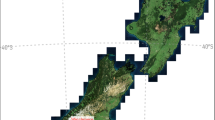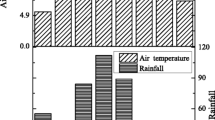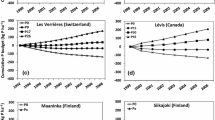Abstract
Decreases in Colwell bicarbonate soil test P in the years after applying single (ordinary) superphosphate, and the residual value of superphosphate, was measured in a long-term field experiment on a duplex (texture contrast) soil (sand over lateritic ironstone gravel clay sand at 10–15 cm), at Wongan Hills, Western Australia, typical of many soils used to grow crops in Western Australia. Ten levels of P (0–91 kg P ha-1) were applied once only in late May to different plots in different years from 1988 to 1993. Wheat (Triticum aestivum), or lupin ( Lupinus angustifolius)) were sown in late May of each year, when the P treatments applied that year were banded (drilled) with the seed. Soil samples were collected each June to measure soil test P. Seed (grain) yields of the crops were measured each December. The residual value (RV) of P applied in previous years was calculated relative to P applied in the current year, using grain yields (RVyield) and soil test P (RVsoil). Soil test P measured on soil samples collected in June was related to yields measured in December that year to provide soil P test calibrations. Relative to P applied in the current year, soil test P decreased by between 15 to 30% for P applied one year previously, by 25 to 30% for P applied three years previously, and by 60 to 70% for P applied six years previously. Soil test P was affected by spatial variation, and it also varied in the different years, for P applied in the current year, one year previously, two years previously, etc. Compared with P applied in the current year, mean RVyield determined in the different years decreased by about 40% one year after P application, followed by a further 20% decrease for P applied two years previously, followed by a further 20% decrease for P applied three to five years previously. Relative to current P, RVsoil decreased by about 25% one year after P application, followed by a further 20% for P applied two years previously, followed by a further 10% for P applied three years ago, and followed by a further 6% for P applied four and five years ago. As measured in the different years, the soil P test calibration varied between years for P applied one, two etc. years previously. This was so even when the same cultivar of wheat was grown at the same site in different years.
Similar content being viewed by others
References
Allen DG & Jeffery RC (1990) Methods of analysis of phosphorus in Western Australian soils. Report of Investigation No. 37. Chemistry Centre (WA), East Perth
Allen DG, Jeffery RC & D'Ercole R (1991) Phosphate and sulphate adsorption properties of soils from the coastal plain of the southwest of Western Australia. Chemistry Centre (WA), East Perth
Anderson WK, Belford RK, Crosbie GB, Loss SP, Mason MG & Perry MW (1991) Crop management. In: MW Perry & B Hillman (eds) The Wheat Book. Ch 6, pp 87–115. Agriculture Western Australia, Perth, Bull 4196
AOAC (1975) Official Methods of Analysis. 12 edn. Assoc. Offic. Agric. Chem., Washington DC
Bache BW & Williams EG (1971) A phosphate sorption index for soils. J Soil Sci 22: 289–301
Barnhisel R & Bertsch PM (1982) Aluminum. In: AL Page (ed) Methods of Soil Analysis, Part 2. pp 275–300. Am Soc Agron Mono 9, Madison, Wisconsin, USA
Barrow NJ (1980) Evaluation and utilization of residual phosphorus in soils. In: FE Khasawneh, EC Sample & EJ Kamprath (eds) The Role of Phosphorus in Agriculture. Ch 13, pp 333–359. Am Soc Agron, Madison, WI, USA
Barrow NJ (1985) Comparing the effectiveness of fertilizers. Fert Res 8: 85–90
Barrow NJ & Campbell NA (1972) Methods of measuring the residual value of fertilizers. Aust J Exp Agric Anim Husb 12: 501–510
Barrow NJ & Shaw TC (1976) Sodium bicarbonate as an extractant for soil phosphate. I. Separation of the factors affecting the amount of phosphate displaced from soil from those affecting secondary adsorption. Geoderma 16: 91–107
Bingley JB (1959) Simplified determination of molybdenum in plant material by 4-methyl-1, 2-dimercaptobenzene, dithol. J Agri Food Chem 7: 269–270
Bingley JB (1963) Determination of molybdenum in biological materials with dithol. Control of copper interferences. J Agic Food Chem 11: 130–131
Bolland MDA (1986) Residual value of phosphorus from superphosphate for wheat grown on soils of contrasting texture near Esperance, Western Australia. Aust J Exp Agric 26: 209–215
Bolland MDA & Allen DG (1998) Spatial variation of soil test phosphorus and potassium, oxalate-extractable iron and aluminium, phosphorus-retention index, and organic carbon content in soils of Western Australia. Commun Soil Sci Plant Anal 29: 381–392
Bolland MDA & Barrow NJ (1991) The effect of level of application on the residual value of superphosphate on a sandy soil in southwestern Australia. Fert Res 29: 163–172
Bolland MDA & Gilkes RJ (1989) Reactive rock phosphate fertilizers and soil testing for phosphorus: the effect of particle size of the rock phosphate. Fert Res 21: 75–93
Bolland MDA & Jarvis RJ (1996) Effectiveness of different methods of applying superphosphate for lupins grown on sandplain soils. Aust J Exp Agric 36: 707–715
Bolland MDA & Wilson IR (1994) Soil phosphorus testing: 1. Studies on spatial variation of Colwell soil test phosphorus. Commun Soil Sci Plant Anal 25: 2371–2384
Bolland MDA, Allen DG & Gilkes RJ (1989) The influence of seasonal conditions, plant species and fertilizer type on the prediction of plant yield using the Colwell bicarbonate soil test for phosphate. Fert Res 19: 143–158
Bolland MDA, Baker MJ & Lunt RJ (1987a) Effectiveness of superphosphate and crandallite-millisite rock phosphates on a deep, very sandy soil as assessed by plant growth and soil extractable phosphate. Aust J Exp Agric 27: 647–656
Bolland MDA, Gilkes RJ & Allen DG (1988a) The residual value of superphosphate and rock phosphates for lateritic soils and its evaluation using three soil phosphate tests. Fert Res 15: 253–280
Bolland MDA, Gilkes RJ & D'Antuono MF (1988b) The effectiveness of rock phosphate fertilizers in Australian agriculture: a review. Aust J Exp Agric 28: 655–688
Bolland MDA, Gilkes RJ, Allen DG & D'Antuono MF (1987b) Residual value of superphosphate and Queensland rock phosphate for serradella and clover on very sandy soils as assessed by plant growth and bicarbonate-soluble phosphorus. Aust J Exp Agric 27: 275–282
Colwell JD (1963) The estimation of the phosphorus fertilizer requirements of wheat in southern New South Wales by soil analysis. Aust J Exp Agric Anim Husb 3: 190–197
Dahnke WC & Olson RA (1991) Soil test correlation, calibration and recommendation. In: RL Westerman (ed) Soil Testing and Plant Analysis, pp 45–71. Soil Sci Soc Am, Madison, WI, USA
Fixen PE & Grove JH (1991) Soil testing for phosphorus. In: RL Westerman (ed) Soil Testing and Plant Analysis pp 141–179. Soil Sci Soc Am, Madison, WI, USA
Gilkes RJ & Lim-Nunez R (1980) Poorly soluble phosphates in Australian superphosphates: their nature and availability to plants. Aust J Soil Res 31: 85–95
Gillman GP & Sumpter EA (1986) Modification of the compulsive method for measuring exchange characteristics of soils. Aust J Soil Res 24: 61–66
James DW & Wells KL (1991) Soil sample collection and handling: Techniques based on source and degree of field variability. In: RL Westerman (ed) Soil Testing and Plant Analysis. Soil Sci Soc Am, Madison, WI, USA
Jarvis RJ & Bolland MDA (1991) Lupin grain yields and fertilizer effectiveness are increased by banding superphosphate below the seed. Aust J Exp Agric 31: 357–366
Loveday J (1974) Methods for analysis of irrigated soils. Commonwealth Bureau of Soils, Tech Commun No. 54
McQuaker NR, Brown DF & Kluckner PD (1979) Digestion of environmental materials for analysis by inductive plasma-atomic emission spectrometry. Anal Chem 51: 1082–1084
Murphy J & Riley JP (1962) A modified single solution method for the determination of phosphate in natural water. Anal Chim Acta 27: 31–36
Nelson P & Delane R (1990) Producing lupins in Western Australia. Bulletin 4179, Western Australian Department of Agriculture, Perth
Olsen SR, Cole CV, Watanabe FS & Dean LA (1954) Estimation of available phosphorus in soils by extraction with sodium bicarbonate. US Dep Agric Circ No. 939
Ozanne PG & Shaw TC (1967) Phosphate sorption by soils as a measure of the phosphate requirement for pasture growth. Aust J Agric Res 18: 601–612
Ratkowsky DA (1983) Nonlinear Regression Modelling: a Unified Practical Approach. Marcel Dekker, New York
Ratkowsky DA (1990) Handbook of Nonlinear Regression Models. Marcel Dekker, New York
Reuter DJ, Edwards DG & Wilhelm NS (1997) Temperate and tropical crops. In: DJ Reuter & JB Robinson (eds), Plant Analysis — an Interpretation Manual. Ch 5, pp 83–278. CSIRO Publishing, Melbourne
Robson AD & Gilkes RJ (1980) Fertilizer responses (N, P, K, S, micronutrients) on lateritic soils in south-western Australia — a review. In: International Seminar on Laterization Processes, pp 381–390. Oxford and IBM Publ Co, London
Ross GJS (1980) ‘MLP Maximum Likelihood Program’ (Rothamsted Exp Stat: Harpenden, UK)
Thomas GW & Peaslee DE (1973) Testing soils for phosphorus. In: LM Walsh & JO Beaton (eds) Soil Testing and Plant Analysis, pp 115–132. Soil Sci Soc Am, Madison, WI, USA
Walkley A & Black IA (1934) An examination of the Degtjareff method for determining soil organic matter and a proposed modification of the chromic and titration method. Soil Sci 37: 29–38
Weatherley, AJ (1993) Investigations of the agronomic effectiveness of rock phosphate fertilizers through laboratory, glasshouse and field experiments with soils from south-western Australia. PhD Thesis, The University of Western Australia, Perth
Wild A (1958) The phosphorus content of Australian soils. Aust J Agric Res 9: 193–204
Yuen SH & Pollard AG (1954) Determination of nitrogen in agricultural materials by the Nessler reagent. II. Micro-determinations in plant tissue and in soil extracts. J Sci Food Agric 5: 364–369
Author information
Authors and Affiliations
Rights and permissions
About this article
Cite this article
Bolland, M. Decreases in Colwell bicarbonate soil test P in the years after addition of superphosphate, and the residual value of superphosphate measured using plant yield and soil test P. Nutrient Cycling in Agroecosystems 54, 157–173 (1999). https://doi.org/10.1023/A:1009730414288
Issue Date:
DOI: https://doi.org/10.1023/A:1009730414288




